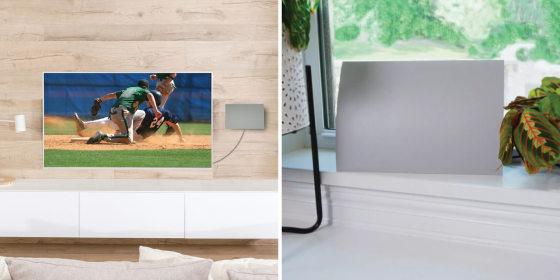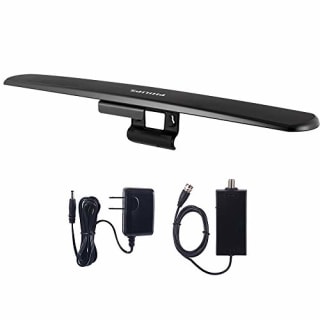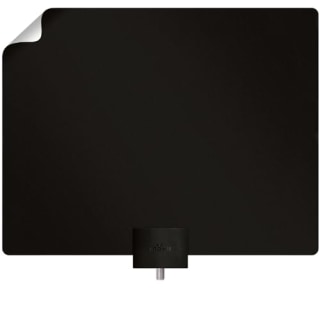Indoor TV antennas are still a sensible purchase, despite the advent of Wi-Fi enabled smart TVs and online streaming services. For anyone who wants to cut the cord on cable TV or reliably access TV channels without a strong internet connection, an indoor TV antenna is just the thing to get free, over-the-air channels in your home. These ‘free-to-air’ channels are those disseminated over TV or radio signals, meaning that anyone with a means of channeling that signal can use it. You won’t get Netflix, but it’s possible to tune in to big broadcasters like NBC, ABC, CBS and FOX without paying a penny.
However, not all indoor TV antennas are created equal, and you’ll want to make sure that your specific model has the range to pick up signals from your closest TV tower. To help you find the right model, I put together a list of what I think are the best indoor TV antennas, with insight and advice from industry professionals and technology experts.
SKIP AHEAD The best Indoor TV antenna | How to shop for the best Indoor TV antenna | Why trust NBC Select?
Want more from NBC Select? Sign up for our newsletter, The Selection, and shop smarter.
The best Indoor TV antenna
- Paper-thin design
- Reversible colors
- 35 mile range only
- Wall or window installation
Channel Master FLATennaThis HDTV antenna comes recommended by gadget expert and technology reporter Christian de Looper, who praised its “great range and slim design”. The Channel Master FLATenna is as flat as the name suggests, with both black and white sides to help it blend it more easily with your indoor decor. This base model has a range of up to 35 miles, with a 12-foot coaxial cable, though you should likely keep it near a window to ensure it maintains a strong connection.
Manufacturer: Channel Master | Type: Indoor | Range: 35 miles | Cable length: 12 feet | Dimensions: 9 x 13 x 0.25 in.
Mohu Curve
- Amplified 60 mile range
- 16-foot cable
- Requires shelf or table
The Mohu Curve is a “better option for those who want something they can put on a shelf or table, without having to attach the antenna to a window,” says de Looper, with a curved design that lets it stand upright on a flat surface. This ‘amplified’ model can also reach up to a 60 mile range at the flip of a switch.
Manufacturer: Mohu | Type: Indoor | Range: 60 miles | Cable length: 16 feet | Dimensions: 11.75 x 2.5 in.
Philips Amplified Digital TV Antenna
- 50 mile range
- Discrete design
- Attaches to top of TV
This Philips indoor TV antenna has a 4 star Amazon rating from over 8,800 reviews.It also has an intriguing, horizontal design, where the antenna is attached to the top of the TV screen itself. This prevents it taking up unwanted space on a shelf, or blocking out a portion of your window or wall. With an amplified 50 mile maximum range, you’ll be able to get plenty of channels at a good distance.
Manufacturer: Philips | Type: Indoor | Range: 50 miles | Cable length: N/A | Dimensions: 18.98 x 2.9 x 4.7 in.
Mohu Leaf Plus
- Amplified 60 mile range
- 16-foot cable
- Wall or window installation
This premium Mohu model combines the thin construction and wall installation of the FLATenna with the extensive coaxial cable and amplified 60 mile range of the Mohu Curve. At $60, it’s a little pricier than other models in this list, but it should do the trick for those after an impressive range and an unobtrusive design.
Manufacturer: Mohu | Type: Indoor | Range: 60 miles | Cable length: 16 feet | Dimensions: 11.38 x 9.25 x 0.04 in.
How to shop for the best Indoor TV antenna
Indoor TV antennas are often forgotten by the TV-viewing public because not everyone is aware of how much content you can get at no additional cost.
The first thing to check is the range of your prospective TV antenna. Richard Schneider, the Founder and President of Antennas Direct, tells us that antennas are usually capable of “40 miles, maybe 50 miles of range for an indoor antenna, and then about 80 or 90 miles for an outdoor antenna”. (Schneider uses an app called Antenna Point that calculates your distance from the nearest tower.)
Schneider says that “The most important consideration to make is the range on offer by the antenna. Keep in mind that you likely won’t get the range advertised by the manufacturer of the antenna in the real world, especially if you live in a densely populated city with lots of radio frequency interference and tall buildings, or in an area with lots of mountains in the way. For those that do struggle to get a good signal, an amplified antenna might be worth considering.”
Schneider adds “you’ll want to consider the length of the cable attached to the antenna, given the fact that you’ll usually want to place the antenna near or on a window, and you may not have a window close to your TV. You may also want to consider design — who wants a big ugly device attached to one of their windows?”
Meet our experts
At NBC Select, we work with experts who have specialized knowledge and authority based on relevant training and/or experience. We also take steps to ensure all expert advice and recommendations are made independently and without undisclosed financial conflicts of interest.
- Christian de Looper is a consumer technology reporter for Tom’s Guide, Digital Trends and TechRadar, with years of experience testing and reporting on household gadgets.
- Richard Schneider is the President and Founder of Antennas Direct, a HDTV antenna business launched in 2003 and a public advocate of cord-cutting and free-to-air television.
Why trust NBC Select?
I've worked as a gadget reporter since 2017, covering the latest developments in consumer hardware, from TVs and projectors to smart speakers and VR headsets. I report on cybersecurity for The Independent and previously worked as the Home Cinema Editor at TechRadar.
Catch up on NBC Select’s in-depth coverage of tech and tools, wellness and more, and follow us on Facebook, Instagram, Twitter and TikTok to stay up to date.









